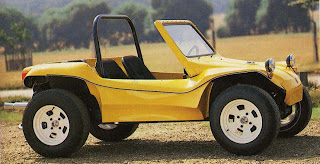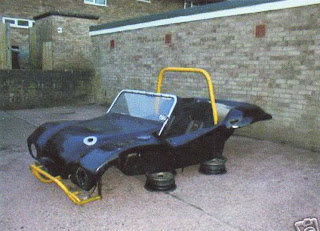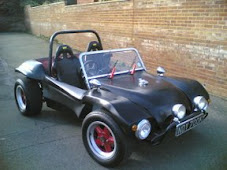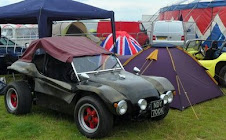
I did not know exactly how the windscreen fitted onto the car and initially fastened it to the dashboard , I was not aware that it need to go over the bonnet and fasten the back end down. However fitting the screen to the car allowed me to see how the screen fitted to the car and how the dash board and the steering wheel interacted with each other. It was quite lucky that I did this and took some pictures as my local Beach Buggy Group at http://www.beachbuggy.org.uk/ commented on the suggesting the rake of the windscreen looked the wrong angle. This was odd as the bolt holes where already in place in the dashboard. This was further clear to me when the distance from the steering wheel was measured to the screen . There was only an inch between the edge of the wheel and the glass , this was clearly not satisfactory.
I removed the screen and looked at the dash frame. It had been made out what looked like metal right angle brackets this had been welded onto the dash frame to bring it forward . I placed the bonnet on the car and checked the bonnet holes . Funny enough there was holes in the right place for the bonnet to fix. It looked as if I had picked the wrong holes. Whilst having the bonnet on the car It was noticeable how difficult it was going to be to do nuts up in the inside of the dashboard to bolt on the screen and bonnet. I decided that I would have to make a solution to hold the nuts in place. My initial idea was to use my Nut insertion kit to place a nut in the hole. It was soon clear that because the frame was made from two strips of metal that this would not work as one of the holes went between the two pieces of metal. The only solution was to make up a backing plate that had nuts welded onto it. Once in place a third bolt would hold the plate with the nuts in place securely so that the bonnet and the screen could be fitted and a screw driver through the hole would position the backing plate with the nuts on so that a bolt could be inserted.

The procedure was a good one and by the end of afternoon I had the bonnet and windscreen on the buggy. As the sun went down I was very pleased with my work. My SWB Rat started to look like a car for the first time and was actually driveable although I still had a lot to do. I had purchased some GP side pods from ebay and wanted to fit them. I also wanted to get the car running properly as it was still backfiring and not running correctly.


.jpg)


















